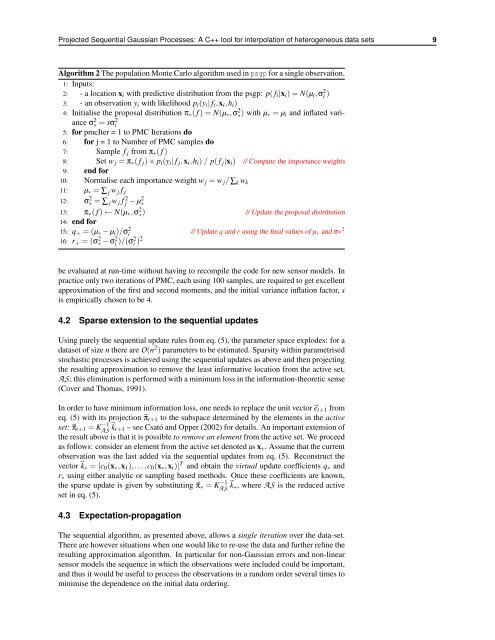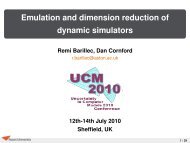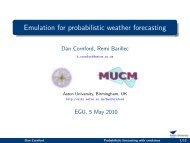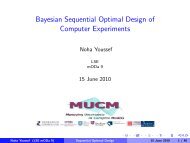Projected Sequential Gaussian Processes: A C++ tool for ... - MUCM
Projected Sequential Gaussian Processes: A C++ tool for ... - MUCM
Projected Sequential Gaussian Processes: A C++ tool for ... - MUCM
You also want an ePaper? Increase the reach of your titles
YUMPU automatically turns print PDFs into web optimized ePapers that Google loves.
<strong>Projected</strong> <strong>Sequential</strong> <strong>Gaussian</strong> <strong>Processes</strong>: A <strong>C++</strong> <strong>tool</strong> <strong>for</strong> interpolation of heterogeneous data sets 9<br />
Algorithm 2 The population Monte Carlo algorithm used in psgp <strong>for</strong> a single observation.<br />
1: Inputs:<br />
2: - a location xi with predictive distribution from the psgp: p( fi|xi) = N(µi,σ 2 i )<br />
3: - an observation yi with likelihood pi(yi| fi,xi,hi)<br />
4: Initialise the proposal distribution π∗( f ) = N(µ∗,σ 2 ∗) with µ∗ = µi and inflated variance<br />
σ 2 ∗ = sσ 2 i<br />
5: <strong>for</strong> pmcIter = 1 to PMC Iterations do<br />
6: <strong>for</strong> j = 1 to Number of PMC samples do<br />
7: Sample f j from π∗( f )<br />
8: Set w j = π∗( f j) × pi(yi| f j,xi,hi) / p( f j|xi) // Compute the importance weights<br />
9: end <strong>for</strong><br />
10: Normalise each importance weight w j = w j/∑k wk<br />
11: µ∗ = ∑ j w j f j<br />
12: σ2 ∗ = ∑ j w j f 2 j − µ2∗ 13: π∗( f ) ← N(µ∗,σ 2 ∗)<br />
14: end <strong>for</strong><br />
// Update the proposal distribution<br />
15: q+ = (µ∗ − µi)/σ2 i<br />
// Update q and r using the final values of µ∗ and σ∗2 16: r+ = (σ 2 ∗ − σ 2 i )/(σ2 i )2<br />
be evaluated at run-time without having to recompile the code <strong>for</strong> new sensor models. In<br />
practice only two iterations of PMC, each using 100 samples, are required to get excellent<br />
approximation of the first and second moments, and the initial variance inflation factor, s<br />
is empirically chosen to be 4.<br />
4.2 Sparse extension to the sequential updates<br />
Using purely the sequential update rules from eq. (5), the parameter space explodes: <strong>for</strong> a<br />
dataset of size n there are O(n 2 ) parameters to be estimated. Sparsity within parametrised<br />
stochastic processes is achieved using the sequential updates as above and then projecting<br />
the resulting approximation to remove the least in<strong>for</strong>mative location from the active set,<br />
AS; this elimination is per<strong>for</strong>med with a minimum loss in the in<strong>for</strong>mation-theoretic sense<br />
(Cover and Thomas, 1991).<br />
In order to have minimum in<strong>for</strong>mation loss, one needs to replace the unit vectoret+1 from<br />
eq. (5) with its projection πt+1 to the subspace determined by the elements in the active<br />
set: πt+1 = K −1<br />
AS kt+1 – see Csató and Opper (2002) <strong>for</strong> details. An important extension of<br />
the result above is that it is possible to remove an element from the active set. We proceed<br />
as follows: consider an element from the active set denoted as x∗. Assume that the current<br />
observation was the last added via the sequential updates from eq. (5). Reconstruct the<br />
vectork∗ = [c0(x∗,x1),...,c0(x∗,xt)] T and obtain the virtual update coefficients q∗ and<br />
r∗ using either analytic or sampling based methods. Once these coefficients are known,<br />
the sparse update is given by substituting π∗ = K −1<br />
AS k∗, where AS is the reduced active<br />
set in eq. (5).<br />
4.3 Expectation-propagation<br />
The sequential algorithm, as presented above, allows a single iteration over the data-set.<br />
There are however situations when one would like to re-use the data and further refine the<br />
resulting approximation algorithm. In particular <strong>for</strong> non-<strong>Gaussian</strong> errors and non-linear<br />
sensor models the sequence in which the observations were included could be important,<br />
and thus it would be useful to process the observations in a random order several times to<br />
minimise the dependence on the initial data ordering.






